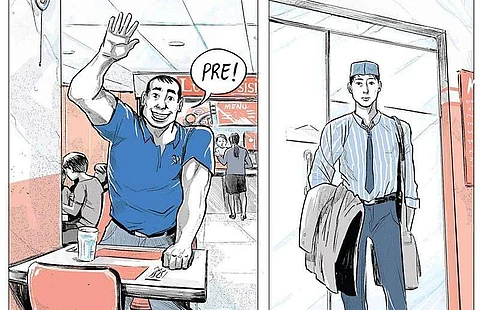Review: Maalaala Mo Komiks: Emiliana Kampilan’s Dead Balagtas Tomo 1
“PROBABLY just another children’s book,” people might say to themselves as they give this graphic novel just a passing glance at the bookstore.
You can’t blame them, since this book could be found at or near the children’s books section in places like Fully Booked. You can’t blame the bookstore people either, since this book probably came in with the rest of the consignment from Adarna House, a publisher famous for its children’s books. If it wasn’t for the online book club Flips Flipping Pages, I probably would’ve remained none the wiser.
Take a closer look at the cover and you’ll see an outline of a skull wearing a laurel wreath and a barong; maybe it’s not a children’s book at all (it’s not). That skull, I presume, serves as the logo for a planned series of books whose first installment is the one I’ve just described – namely, Dead Balagtas Tomo 1: Mga Sayaw ng Dagat at Lupa (or in English, Dead Balagtas Volume 1: Dances of Sea and Land).
The book’s namesake is Francisco Balagtas, the enigmatic Spanish era poet who wrote Florante and Laura, a Tagalog epic set in medieval Albania.
While Balagtas doesn’t make an appearance anywhere in this particular work, perhaps he might be in a future volume. Emiliana Kampilan, the pseudonymous artist behind Dead Balagtas, has mentioned in interviews that two of her greatest passions are comics and Philippine history, and so it goes without saying that her series will present her visual take on the things of our past most people only hear and talk about in classrooms.
Though too shy to reveal her face when making public appearances, Kampilan isn’t shy at all when it comes to revealing her leftist leanings in her art. Aside from comic strips and samples, you can also find feisty illustrations reminiscent of Soviet and Maoist propaganda posters on the Dead Balagtas Facebook page. I’ve taken enough college literature classes and read enough modern works of fiction to say that most leftist authors tend to gleefully inject so much Marxism into their works that they make the plots feel so forced, contrived, and preachy most of all – but thankfully, this doesn’t seem to be the case with Kampilan in Dead Balagtas Tomo 1.
If anything, the three stories depicted wouldn’t look out of place if they were presented as real-life accounts in that Saturday evening favorite of the masses, the long-running drama anthology Maalaala Mo Kaya.
In the first story, a young boy and girl united in their love for video games drift apart as they grow up, go their separate ways, and pursue careers that have nothing in common with one another.
The second story has us follow the young and handsome Muslim trader Rahman as he strikes up an unlikely friendship with the similarly-named, burly department store worker Ramon – and how this friendship might be leading to something more, as Kampilan points to a secret struggle of Rahman’s that has been tearing him apart since boyhood.
Finally, the third and last story tells of how two girls from very different backgrounds fall in love, elope, and deal with the consequences of such a rash, life-altering decision. If I’m not mistaken, this is the longest of the three stories and also the most lovingly drawn, and so I shall give it its own treatment in a separate review.
Those of you who have read the book will notice that up until now, I’ve left out what I believe to be the book’s preface, wherein a babaylan (shamaness) sings her version of the native creation myth – that a cosmic tango or some such between a masculine essence and his feminine counterpart and lover brought the world into existence from out of the void.
In terms of visuals, this is indisputably the best part of the book; take a panel, any panel, from this part and enlarge it, and it would look like it belongs in an art museum instead of a comic book.
With such a preface, Kampilan would then have to frame the relationship dynamics in her three stories as metaphors for the primordial tectonic shifts that brought about the archipelago now known as the Philippines.
And so, it turns out that there is some contrivance in this book after all: not because of Kampilan’s communist sympathies, surprisingly, but instead because she sincerely wanted to work some mythology and earth science into her debut opus (as evidenced by the references she lists at the end of her book).
In spite of this and other flaws, Dead Balagtas Tomo 1 is definitely a must-have for comics aficionados and lovers of Philippine literature (like the good people at Flips Flipping Pages – check them out on Facebook!). On top of that, I’d like to recommend this graphic novel to people who collect art books and coffee table books as a hobby, and for people who are still unsure of what to get as a gift for their backpacker friend from the west who just fell in love with this country.

